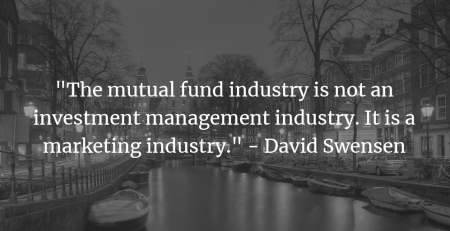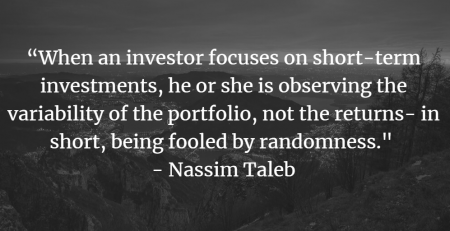Investing Superpower: Long-Term Thinking
In our most recent quarterly update, we talked about the importance of long-term thinking in a world that is increasingly dominated by short-term news flow. Not to belabor the point, but this concept is so fundamentally important to what we do here at Globescan that we felt it deserved its own article.
When we really get down to it, stock values are determined by only two factors:
- Fundamentals – Earnings per share, cash flow, return on invested capital, etc.
- Sentiment – How much the market is willing to pay for those fundamentals in the form of a multiple, discount rate, etc.
For example, pretend we knew for certain that a company was going to generate $2.00 in earnings per share every year until the end of time. Those are the fundamentals. And let’s assume the market is willing to pay 20x one year’s earnings for the company (which is equivalent to using a 5% discount rate). That is the sentiment. Combine the two ($2.00 in earnings x 20x earnings multiple) and the stock price is $40.
So, we buy at $40 and print our 5% earnings yield ($2 earnings on $40 stock price) till the end of time. Simple enough right? Unfortunately, not. The fundamentals here may be constant in our example, but the sentiment is largely unpredictable. Rather, whether a stock trades at a 20x or a 10x multiple is decided by thousands of market participants who are known for acting irrationally – they herd, panic, get overly greedy, get overly fearful, and generally do a poor job of determining actual value in the short term.
Say the market does decide our $2.00 earnings stream is only worth 10x rather than 20x. There are a lot of reasons this could be the case – maybe the market doesn’t think that $2.00 earnings is sustainable long term, or maybe the market thinks there are better opportunities elsewhere, or maybe that company or ‘style’ is just out of favor this month. Or maybe there are so many people investing passively that multiples are getting forced in one direction by the sheer weight of the flows. For whatever reason, we just lost 50% on our fundamentally certain investment.
We basically have two options at this point:
- Attempt to forecast the mood of the market, predicting when the market will wake up sad or happy, and capitalize on that by trading in an out of the market, buy at 10x, sell at 20x valuations. This is known as short-term trading, and as you can imagine is next to impossible to do consistently (despite how many people and firms claiming that they can).
- We ignore sentiment altogether and focus exclusively on the fundamentals. This is called long-term investing – i.e. if we know we are going to get that $2.00 per year, it doesn’t matter if our $40 investment turns into a $20 investment in the short term, we will continue to get that $2.00 every single year.
Long-term investors have an advantage in the market since they can focus on the knowable fundamentals of an investment and largely ignore the unknowable sentiment side of the equation. For example, If we can find companies that are highly likely to produce 10% earnings growth for decades to come, it doesn’t matter if the multiple gets cut in half from one year to the next, as we’ll still make a great return over a decade.
So, the question for long-term investors becomes: How do we consistently pick companies that will be able to grow earnings over long periods of time? We have talked about this before, but for us it comes down to two main factors:
- Moats – Barriers that protect a business from competition. For example, if you own the only landfill in town and it’s nearly impossible to build another because of regulations, you are insulated from competition and have pricing power.
- Growth Runway – How large is the market opportunity versus how much do you already control. For example, many older companies might already have captured a full and mature market, meaning their growth opportunities will be limited to the growth of that market, which for mature industries rarely exceeds GDP growth.
Once we are comfortable with these two factors and feel we can predict a company’s fundamentals many years out, we will begin to develop a model for how valuable an investment is to us. For example, a business that we are confident will grow revenue 4% per year, with say 2% margin expansion, plus a 1% dividend/share buyback, would get us to a 7% total annual shareholder return. At this point, it is largely a question of what price is the market offering the investment to us and whether we can do better elsewhere?
It is only when an investor has done this work – identified a moat, identified a growth runway, and developed an understanding of the company’s value – that they will be able to hold an investment long term even when the market is having a mood swing and crashing 50% in any given year. And more importantly, it is only when an investor has done this work, that they will be able to know whether the market’s price fluctuations are simply due to short-term sentiment shifts, or if something has fundamentally changed with the investment thesis.
If it is the former, then the market is simply giving us the opportunity to buy a fundamentally solid business at a fire sale price. For us, that is what long-term investing is all about – arbitraging the difference between short-term sentiment shifts and long-term business fundamentals.
Disclosures: This website is for informational purposes only and does not constitute an offer to provide advisory or other services by Globescan in any jurisdiction in which such offer would be unlawful under the securities laws of such jurisdiction. The information contained on this website should not be construed as financial or investment advice on any subject matter and statements contained herein are the opinions of Globescan and are not to be construed as guarantees, warranties or predictions of future events, portfolio allocations, portfolio results, investment returns, or other outcomes. Viewers of this website should not assume that all recommendations will be profitable or that future investment and/or portfolio performance will be profitable or favorable. Globescan expressly disclaims all liability in respect to actions taken based on any or all of the information on this website.
There are links to third-party websites on the internet contained in this website. We provide these links because we believe these websites contain information that might be useful, interesting and or helpful to your professional activities. Globescan has no affiliation or agreement with any linked website. The fact that we provide links to these websites does not mean that we endorse the owner or operator of the respective website or any products or services offered through these sites. We cannot and do not review or endorse or approve the information in these websites, nor does Globescan warrant that a linked site will be free of computer viruses or other harmful code that can impact your computer or other web-access device. The linked sites are not under the control of Globescan, and we are not responsible for the contents of any linked site or any link contained in a linked site. By using this web site to search for or link to another site, you agree and understand that such use is at your own risk.






